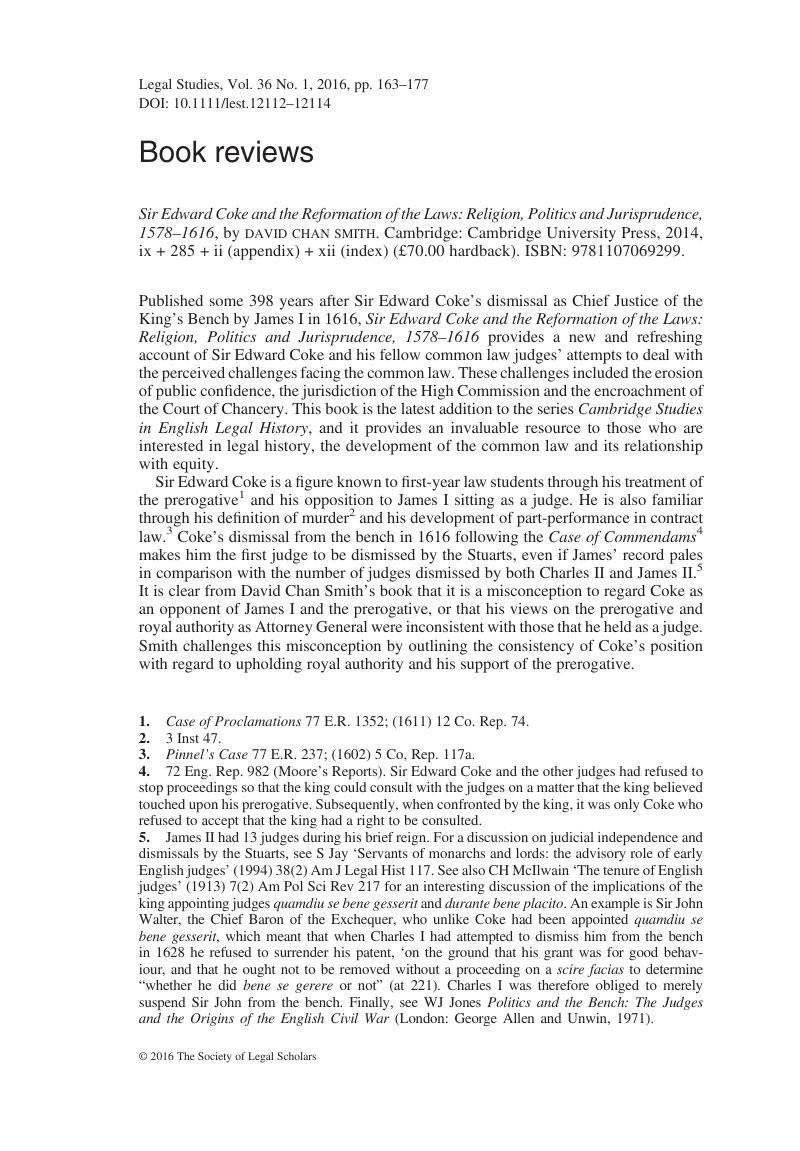No CrossRef data available.
Published online by Cambridge University Press: 02 January 2018

1. Case of Proclamations 77 E.R. 1352; (1611) 12 Co. Rep. 74.
2. 3 Inst 47.
3. Pinnel's Case 77 E.R. 237; (1602) 5 Co, Rep. 117a.
4. 72 Eng. Rep. 982 (Moore's Reports). Sir Edward Coke and the other judges had refused to stop proceedings so that the king could consult with the judges on a matter that the king believed touched upon his prerogative. Subsequently, when confronted by the king, it was only Coke who refused to accept that the king had a right to be consulted.
5. James II had 13 judges during his brief reign. For a discussion on judicial independence and dismissals by the Stuarts, see Jay, S ‘Servants of monarchs and lords: the advisory role of early English judges’ (1994) 38(2) Am J Legal Hist 117 CrossRefGoogle Scholar. See also McIlwain, CH ‘The tenure of English judges’ (1913) 7(2) Am Pol Sci Rev 217 for an interesting discussion of the implications of the king appointing judges quamdiu se bene gesserit and durante bene placito CrossRefGoogle Scholar. An example is Sir John Walter, the Chief Baron of the Exchequer, who unlike Coke had been appointed quamdiu se bene gesserit, which meant that when Charles I had attempted to dismiss him from the bench in 1628 he refused to surrender his patent, ‘on the ground that his grant was for good behaviour, and that he ought not to be removed without a proceeding on a scire facias to determine “whether he did bene se gerere or not”’ (at 221). Charles I was therefore obliged to merely suspend Sir John from the bench. Finally, see Jones, WJ Politics and the Bench: The Judges and the Origins of the English Civil War (London: George Allen and Unwin, 1971)Google Scholar.
6. Boston: Little Brown and Company, 1957. See also Usher, R ‘Sir Edward Coke’ (1930) 15(4) St Louis L Rev 325 Google Scholar; Boyer, AD ‘Coke, Sir Edward (1552–1634)’ in Oxford Dictionary of National Biography (Oxford: Oxford University Press, 2004)Google Scholar; and Boyer, AD (ed) Law Liberty, and Parliament: Select Essays on the Writings of Sir Edward Coke (Indianapolis, MN: Liberty Fund, 2004)Google Scholar. For a nineteenth-century perspective on Sir Edward Coke, see Campbell, Lord J The Lives of the Chief Justices of England: From the Norman Conquest till the Death of Lord Mansfield, vol I (London: John Murray, 1849)Google Scholar; Foss, E The Judges of England; With Sketches of Their Lives and Miscellaneous Notices Connected with the Courts at Westminster, from the Time of the Conquest, vol VI (London: Longman, Brown, Green, Longmans and Roberts, 1857)Google Scholar; Woolrych, HW The Life of The Right Honourable Sir Edward Coke, Knight: Lord Chief Justice of the King's Bench (London: J and WT Clarke, 1826)Google Scholar; and Johnson, CW The Life of Sir Edward Coke, Lord Chief Justice of England in the Reign of James I, vols I and II (London: Henry Colburn, 1845)Google Scholar
7. Smith, D Chan Sir Edward Coke and the Reformation of the Laws: Religion, Politics and Jurisprudence, 1578–1616 (Cambridge: Cambridge University Press, 2014) p 35 CrossRefGoogle Scholar.
8. Ibid, p 37.
9. Ibid, p 42.
10. Ibid, p 41.
11. Ibid, p 43.
12. Ibid, p 44.
13. Ibid, p 45.
14. Ibid, pp 66–68. Barratry was an offence committed by vexatious litigants. According to Smith: ‘the offence was shaped to address concerns about the vexatious behaviour of litigants and their lawyers. Coke defined the “barrettor” as “a common mover and exciter, or maintainer of suits, quarrels, or parts, either in courts, or elsewhere in the country”.’
15. Ibid, p 69.
16. Ibid, p 71.
17. Ibid, p 73.
18. Ibid, p 89.
19. Ibid, p 90.
20. Ibid, p 92.
21. Ibid, p 107.
22. Ibid, p 108.
23. Ibid, pp 110–113.
24. Ibid, p 113.
25. Ibid, p 119.
26. Ibid, p 126.
27. Ibid.
28. Ibid, pp 135–136.
29. Ibid, pp 136–137.
30. Ibid, p 142.
31. Ibid, p 144.
32. Ibid, p 146.
33. Ibid, p 148.
34. Ibid, p 157.
35. Ibid, p 150.
36. Ibid, p 152.
37. 77 E.R. 646; (1610) 8 Co. Rep. 113.
38. Smith, above n 9, p 170.
39. Ibid, p 174.
40. Ibid.
41. Prohibitions Del Roy, 12 Co. Rep. 65.
42. Smith, above n 9, p 178.
43. Ibid.
44. Ibid, p 179.
45. Ibid, p 180.
46. Ibid, p 181.
47. Ibid, pp 199–201.
48. Ibid, p 202.
49. Ibid, pp 208–211.
50. Ibid, p 212.
51. Ibid, p 222.
52. Ibid, p 234.
53. Ibid, pp 234, 247.
54. Ibid, p 246.
55. Ibid, p 250.
56. Ibid, p 260.
57. Ibid.
58. Ibid, pp 264–265.
59. Ibid, p 273.
60. Ibid, p 277.